The ASUS ZenFone 2 Review
by Brandon Chester on May 26, 2015 8:00 AM ESTSystem Performance
To test Intel's Atom Z3580 SoC I've run the phone through our standard suite of benchmarks. These tests range from browser tests that test the speed of the SoC and the browser's Javascript engine, to more native tests like writing text and seeking through videos. Even some tasks that seem simple can be quite demanding on devices where the entire system is limited to a power envelope of around 3W. Luckily, the ZenFone 2 runs Android Lollipop and so it's using Google's new ART runtime for Java based Android applications. However, even ART is limited in what it can do, as AOT compiler optimizations are limited by a need to balance the CPU's limited power with the need to compile apps quick enough that the user isn't stuck waiting long after they are downloaded.
Although it's a bit unfair as it's a tablet, I've included Dell's Venue 8 7000 in these results because it uses the same SoC as the ZenFone 2 and so it makes for an interesting comparison.
As usual, the first tests that I'll be looking at are our browser benchmarks. Sunspider had become such a large optimization target that it's basically gone from our 2015 benchmark suite, which leaves us with Kraken, Octane, and WebXPRT 2013.

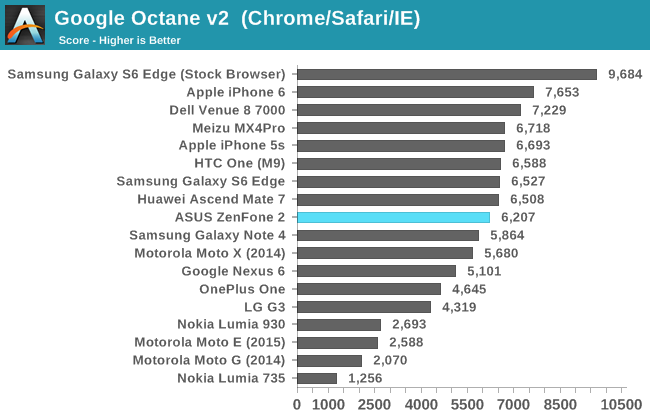
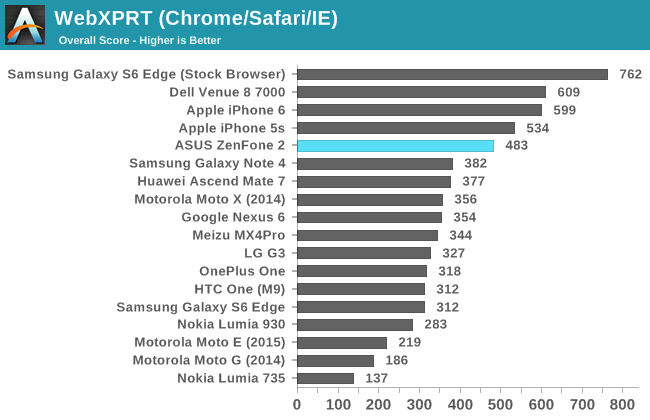
In our web browsing tests the ZenFone 2 performs very well. In the case of Kraken, it does roughly as well as the Venue 8 7000 which uses the same Z3580 SoC. Performance tends to fall behind the Venue 8 in our longer tests like Octane and WebXPRT. I don't have the Venue 8 anymore, but it's a safe bet that this is due to the larger aluminum chassis of the Venue 8 being able to manage heat better in order to keep the clock speeds on the CPU higher during the course of the test.
While the ZenFone 2 isn't quite as fast as a tablet using the same SoC, it's much faster than most of the other devices that we've tested. In general it ends up being a bit slower than the iPhone 5s and the iPhone 6, and of course it loses to the Galaxy S6 using Samsung's browser by an enormous margin in every case. However, a good portion the phones that sit below it are very expensive flagship phones like the Nexus 6, LG G3, and the Galaxy Note 4 which is very impressive for a $300 smartphone.
The next test is Basemark OS II which tests the performance of a device's CPU, GPU, RAM, and NAND.
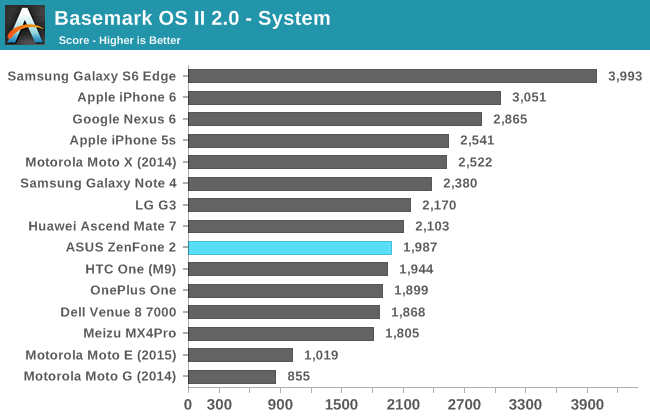
The system sub test performs integer and floating point operations, and also performs some tests like XML parsing. This makes it primarily a test of the device's CPU and RAM. I'm actually somewhat surprised by the ZenFone's performance in this test. By no means is it bad, but I had forgotten that the Venue 8 also struggled to match Snapdragon 801 smartphones in this test.
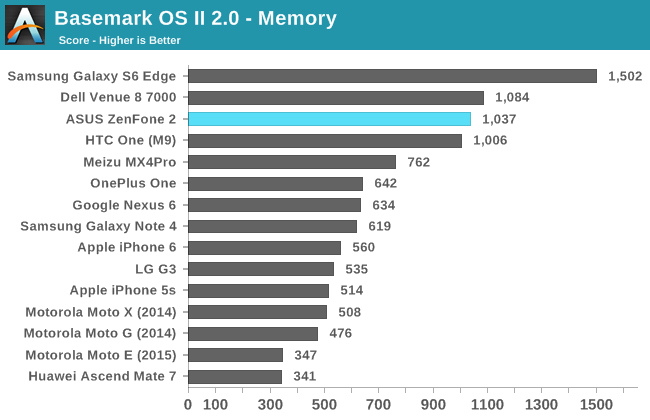
The Basemark OS II memory sub test has a somewhat vague name. While one might expect it to be a test of the device’s RAM, it’s actually a flash storage test. In it we see one of the highest scores of the smartphones we’ve tested, with only the Dell Venue 8 tablet and the Galaxy S6 with its UFS memory achieving higher scores.
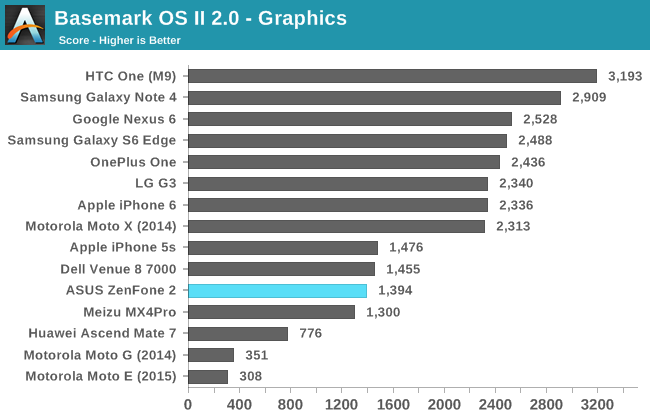
The result in the graphics test is definitely on the lower end of our results, but it’s not unexpected. Both the Venue 8 7000 and the iPhone 5s achieve similar scores, and all three devices use the same G6430 GPU (albeit with lower clock speeds on the iPhone). Even though the ZenFone 2 doesn’t perform as well as the expensive flagship smartphones, it’s far ahead of budget devices like the Moto G. Since both the Z3560 and Z3580 based ZenFone 2 models use the same 533MHz PowerVR G6430 this result should be roughly the same on the $199 model as it is on this $299 model.

The last sub test is the web test. This test focuses on a device’s ability to handle web page rendering, with a focus on HTML5 and CSS rather than Javascript code. In this test we see the ZenFone 2 amongst a large group of devices that includes the HTC One (M9), the Nexus 6, and the Moto X. To see the same level of performance as Snapdragon 805 and 810 devices is very impressive.
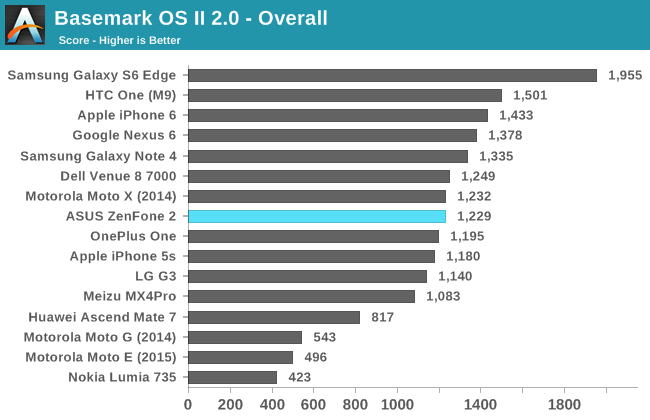
The overall score for BaseMark OS II takes into the account the scores of the various sub tests to generate a final score. In this test we again see the ZenFone 2 around the middle of the pack, with a score that is similar to that of Snapdragon 801 based devices. This is a very good result for a smartphone that costs so little, although the OnePlus One also achieves similar performance at roughly the same price as the $299 model of the ZenFone we are testing.
Our last general performance benchmark is PCMark. This is a relatively new addition to our testing workflow, and it focuses on race to sleep scenarios that reflect the type of usage a device will see in the real world. The tests range from Javascript performance, to playing and seeking in videos, to editing photos.

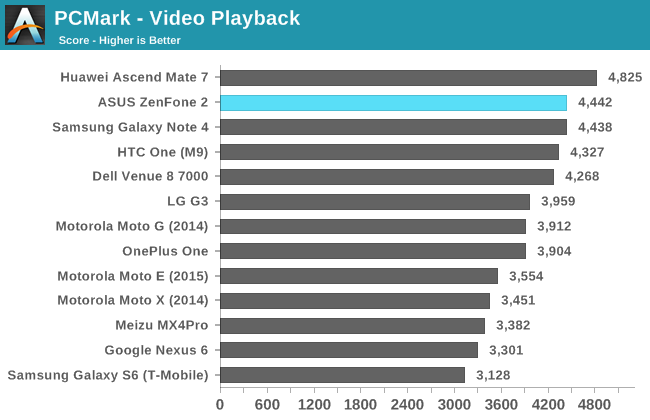
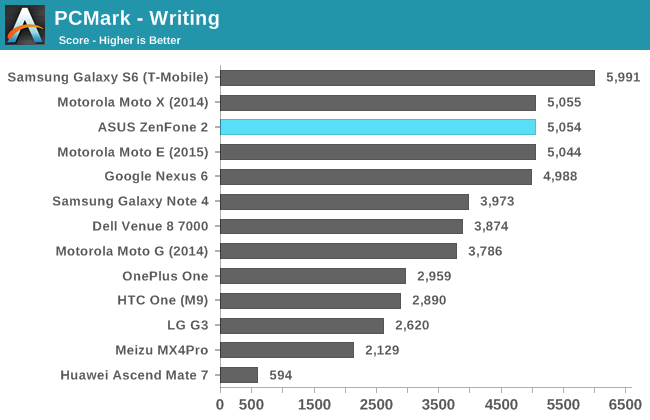
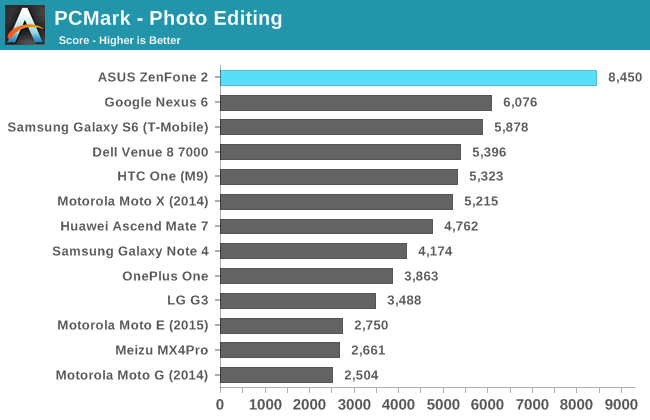
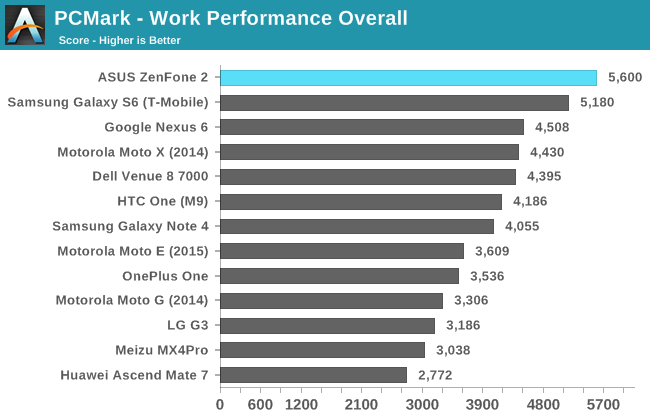
In all of the PCMark sub tests the ZenFone 2 performs extremely well. It’s always at or very close to the top result, and only really loses by a large margin to the Galaxy S6 in the tests that it isn’t right near the top for. The one exception is the photo editing test where it beats every other device by an enormous amount. This score is what carries it to the top position when it comes to the overall score.
I think it’s a bit unfair to say that the ZenFone is the fastest device when it only comes first in a single test, but even without considering the photo editing test it’s clear that the ZenFone 2 offers great performance. Even more amazing is that at times it can trade blows with flagship phones that cost much more than it does. Perhaps due to the fact that it's the only x86 Silvermont-based phone in our benchmarks its relative performance can bounce around versus the competition, but on average it comes rather close to delivering the kind of CPU performance we've seen from the flagship phones over the past year.










147 Comments
View All Comments
quiksilvr - Tuesday, May 26, 2015 - link
I bought a third party Qualcomm Quick Charge 2.0 charger for $15 on Amazon for my Zenfone 2 and it works just fine.http://www.amazon.com/dp/B00OVD3FEU/
grusin123 - Tuesday, May 26, 2015 - link
Camera review focuses just on the asus camera app, which clearly is the weak point. Could you please test it with google camera app? you can download it or any kitkat+ device.It would be interesting to see how it compares against nexus 5 and 6, which both use google camera app.
Kepe - Tuesday, May 26, 2015 - link
Using a different camera app doesn't fix problems with the ISP. Camera apps don't process images, the ISP does. Well, some camera apps may do some extra post-processing after the ISP has done its processing, but still if the ISP oversharpens the images in the "opimized" mode and leaves them blurry in the "no optimizations" mode, there's very little a different camera app could do to change image quality in any significant way. You'll probably end up with less choice for camera settings using a 3rd party camera app, because an app made by someone else probably doesn't know about the "optimized" and "nonoptimized" modes the ASUS camera has.A camera app basically just tells the phone to take a picture with a certain set of parameters, and those parameters are within the same limits no matter what app you use. Some apps may have settings that seem to exceed what the OG app has, but those are usually just some software tricks that make horrible looking images. For example, I've got an app that lets me choose a 20s exposure time, but using that makes images horribly grainy, causes weird light effects and as such produces images that are completely useless. Max exposure in the original camera app is 1s, so the other app probably tries to take multiple images and combine them to a single one, or then it records a 20s video and compresses that into a single image. It's similar with apps that let me choose a higher ISO level than what is offered by the original app. They just use software post-processing to brighten the image after it has been taken.
Kepe - Tuesday, May 26, 2015 - link
*optimized. Still need an edit button... How hard can it be?tmc - Tuesday, May 26, 2015 - link
Can you please comment on cell signal reception? Possibly compare with other phones as well - like you have done for other features. The reason I am asking is that - a new phone (not mentioning the device/brand) that I purchased has like approx 10dBm lower reception than my earlier device (nexus 4) - and this significantly affects LTE. Where I used to get LTE, now I don't. I would think cell reception should be a very important criterion. Thanks.Brandon Chester - Tuesday, May 26, 2015 - link
It didn't seem to be any worse or better than other devices. For reference, I put the phones in a certain spot in order to make sure the LTE signal is strong during the battery life test. The signal strength was basically the same as the iPhone 5s or the Galaxy S6 in that same spot.tmc - Tuesday, May 26, 2015 - link
Thanks. That helps.velanapontinha - Tuesday, May 26, 2015 - link
Hi, Brandon.Any ETA on the review of the "regular" MX4? MWC is long over.
AnandTech still doesn't have one single review of a Mediatek based device. Mediatek is no longer a Cyrix kind of thing, you guys should give it the spotlight it is starting to deserve.
Maxpower2727 - Tuesday, May 26, 2015 - link
I hate to be "that guy," but....G4 review?re2onance - Tuesday, May 26, 2015 - link
Thanks for the detailed review of the battery life. Did you use the Asus web browser or Google Chrome for the web browsing battery test?